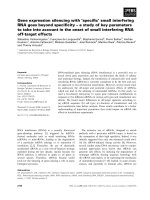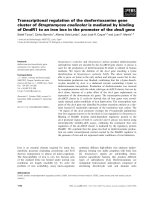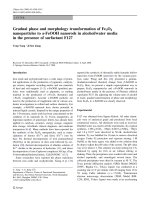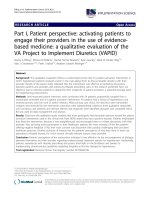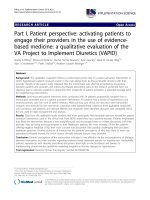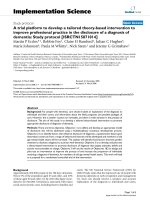Using total reflection X-ray fluorescense (TXRF) to analyse trace elements in surface water of Xuan Huong lake – Dalat city
Bạn đang xem bản rút gọn của tài liệu. Xem và tải ngay bản đầy đủ của tài liệu tại đây (423.88 KB, 7 trang )
TẠP CHÍ KHOA HỌC
TRƯỜNG ĐẠI HỌC SƯ PHẠM TP HỒ CHÍ MINH
HO CHI MINH CITY UNIVERSITY OF EDUCATION
JOURNAL OF SCIENCE
Tập 16, Số 9 (2019): 486-492
ISSN:
1859-3100
Vol. 16, No. 9 (2019): 486-492
Website:
Research Article*
USING TOTAL REFLECTION X-RAY FLUORESCENSE (TXRF)
TO ANALYSE TRACE ELEMENTS IN SURFACE WATER
OF XUAN HUONG LAKE – DALAT CITY
Nguyen An Son*, Suk Soo Dong, Nguyen Thi Minh Sang, Pham Thi Ngoc Ha,
Tran Ngoc Dieu Quynh, Nguyen Dinh Trung, Nguyen Thi Nguyet Ha, Le Viet Huy
DaLat University, Vietnam
Corresponding author: Nguyen An Son – Email:
Received: June 06, 2019; Revised: September 11, 2019; Accepted: September 20, 2019
ABSTRACT
The regular assessment of a water source has been important for safety and pollution
warning. Specifically, the concentration of trace elements in water reflects the pollution level.
Urbanization, industrialization, fertilizers and other plant protection products have negatively
affected the environment; in particular, water and air quality. The main objective of this study was
to evaluate the trace elements contained in surface water from Xuan Huong Lake – Dalat city by
using the technique of Total Reflection X-ray Fluorescence (TXRF). The results show that the
concentrations of some metal elements, such as Iron and Bromine, exceeded the limits by the
Vietnamese standards as well as others in many countries.
Keywords: TXRF, trace elements, surface water, Xuan Huong Lake.
1.
Introduction
Water plays an important role in our life. Water is one of the most important
substances on earth (Alrakabi, 2017). Water from original natural resources which is
indispensable to our life. Nowadays, the use of chemicals arbitrarily in the production of
agriculture environment has increased the risk to water sources. Polluted surface water has
impacted human beings either directly or indirectly (Do, 2015).
Xuan Huong Lake is located in the middle of Dalat city which is highland. Many
water sources flow into this lake, including agriculture water, rain water, and surface
water. Recently, water pollution in Xuan Huong Lake has reached an alarming level.
There have been many methods used to analyze trace minerals in water such as
chemical method, neutron activation analysis, and TXRF technique. The trace element
Cite this article as: Nguyen An Son, Suk Soo Dong, Nguyen Thi Minh Sang, Pham Thi Ngoc Ha, Tran Ngoc
Dieu Quynh, Nguyen Dinh Trung, Nguyen Thi Nguyet Ha, & Le Viet Huy (2019). Using total reflection
X-ray fluorescense (TXRF) to analyse trace elements in surface water of Xuan Huong Lake – Dalat City.
Ho Chi Minh City University of Education Journal of Science, 16(9), 486-492.
486
HCMUE Journal of Science
Nguyen An Son et al.
TXRF technique is one of the best analysis methods because of its accuracy (ppb), ability
to analyze multiple elements with limited destruction of the sample (Do, 2015).
2.
The experiment
2.1. Chemicals and equipment
Galium with amount of 1000 ± 10 mg L−1 is the internal standard solution was
obtained from Merck. A silicone solution in isopropanol was obtained from SERVA
Electrophoresis GmbH (Heidelberg, Germany).
Qualitative and quantitative TXRF analyses were performed with the benchtop S2
PicoFox TXRF spectrometer from Bruker Nano (Germany) (see Fig. 1.). All TXRF
measurements were operated with X-ray tube at 50 kV, 1mA and a multilayer
monochromator at 17.5 keV for Kα line of Mo.
Fig. 1. Schematic working principle of TXRF
2.2. Sample collection
Samples were collected weekly in a rainy season from May 01, 2018 to April 31,
2019 at five different sites from Xuan Huong Lake (Fig. 2).
Fig. 2. Five different sites from Xuan Huong Lake
487
HCMUE Journal of Science
Vol. 16, No. 9 (2019): 486-492
Samples were taken in the places which are the flows in and out of the lake. Site 1
and 2 are the flows in from other places which are called system deposit’s lake. They are
considered as a “mechanic filter” of all water flows before going to Xuan Huong Lake.
Many canals flow in Site 1 which has been polluted and affected by agricultural activities
(Dalat Hasfarm) (EPA, 2001). Site 3 is predicted less polluted than other sites, and it flows
out to Cam Ly water fall. Water in Site 4 was polluted by pipes from Cu Hill (Hoang,
2018). Site 5 is considered to be ‘medium’ polluted of all the sites above.
2.3. Preparation of liquid samples
Gallium of 10 ppb which were internal standard, were added to all samples. For the
optimization of the sample amount, the sample carriers were pretreated with 10μl of
silicone solution and dried for 20 minutes in the oven at 60 °C.
Following the standard procedure, 10μl of a solution containing Ga of 10 ppb and
lake water was disposed on a quartz sample carrier and dried on a heating plate at about
600C in 20 minutes (Fig. 3).
(a)
(b)
Fig. 3. Transfer of the sample onto the sample carrier (a) and drying of the sample (b)
For statistical evaluation, three samples were prepared for each of the two referenced
standards. The measurement time was 600 seconds per each sample.
3.
Results and discussion
The results demonstrate how TXRF can be used to analyze trace elements in fresh
water samples in five different sites at Xuan Huong Lake. The results were averaged for all
samples at the same site. Table 1 describes the quantitative analysis of the results with the
TXRF. Spectrum of TXRF at different sites from Xuan Huong Lake is shown in Fig. 4.
488
HCMUE Journal of Science
Nguyen An Son et al.
Table 1. Comparison of trace elements contents from various sampling sites with the standards
Concentration [ppb] / Error [%]
Element
QCVN 08MT:2015/
BTNMT
[ppb]
Ireland
Standdard
[ppb]
Site No.1
Site No.2
Site No.3
Site No.4
Site No.5
Cl
161
6
185
4
159
7
145
7
127
7
250000
250000
Cr
n.d.
n.d.
6
8
3
6
11
8
n.d.
n.d.
50
50
Mn
60
3
52
4
34
4
41
6
24
3
100
50
Fe
1237
2
1059
4
306
2
544
4
258
2
500
200
Cu
94
2
92
3
69
3
72
4
74
2
100
50
Zn
87
3
135
3
84
2
86
4
116
2
500
3000
As
9
5
14
5
7
5
6
8
6
5
10
50
*
10
Br
123
2
73
3
110
2
137
4
106
2
25
Hg
n.d.
n.d.
n.d.
n.d.
n.d.
n.d.
n.d.
n.d.
n.d.
n.d.
1
1
Pb
n.d.
n.d.
n.d.
n.d.
n.d.
n.d.
n.d.
n.d.
n.d.
n.d.
20
50
Note: n.d is symbol of none detection.
*:
QCVN 01:2009/BYT – National technical regulation on the drinking water quality
Fig. 4. Spectrum of TXRF at different sites from Xuan Huong Lake
All water samples in Xuan Huong Lake contained Cl, Cr, Mn, Fe, Cu, Zn, As, and
Br. The concentrations of Cl, Cr, Mn, Cu, Zn have acceptable limits according to Vietnam
standards (Huynh, 2018).
489
HCMUE Journal of Science
Vol. 16, No. 9 (2019): 486-492
The amount of Br from different locations exceeded about 10 times of acceptable
limits comparing with the standards (Lenntech, 2018; QCVN01: 2009 / BYT, 2009] and
about 10 times comparing with the standard of drinking water in Vietnam (QCVN 08-MT:
2015 / BTNMT, 2015). Bromine is corrosive to human tissue in a liquid state, and its
vapors irritate eyes and throat. Bromine vapors are very toxic when inhaled.
Humans can absorb organic bromines through the skin, with food and during
breathing. Organic bromines are widely used as sprays to kill insects and other unwanted
pests. However, they are not only poisonous to the animals that they are used against, but
also to larger animals. In many cases they are also poisonous to human beings. The most
important health effects that can be caused by bromine-containing organic contaminants
are the malfunctioning of the nervous system functions and disturbances in genetic
materials. In addition, organic bromines can also cause damages to organs such as liver,
kidneys, lungs, and milt. They can cause stomach and gastrointestinal malfunctioning.
Some forms of organic bromines, such as ethylene bromine, can even cause cancer (S2
PICOFOX™) Bromine is contained in agrochemicals, pesticides, dyes, disinfectants,
petroleum, and plastic coatings of electronic devices. The reported high bromine in the
water at the investigated sites is due to the agricultural waste stream containing pesticide
residue which has chemical formula as CH3Br (methyl bromide).
The findings of the study show that the water of Xuan Huong Lake is not safe to use
for drinking (WHO, 2004).
The concentration of Fe at Site 1 and 2 was double than the limits by the Vietnamese
standards. Because the two sites are the flows in Xuan Huong Lake and were affected by
agriculture activities, domestic waste, and sewage sludge. When the high concentration of
iron will make the water yellowish with a foul odor.
At Site 3, the concentrations of the investigated elements are smaller than the rest
because this place is the flow out of Xuan Huong Lake. At site 4, the iron concentration is
1.1 times higher than the standard because this water drains from the Cu Hill. Site 5 in the
middle of the household is the neutral place of the four remaining positions, the
concentrations of the investigated elements there is at the average level between the
surveyed locations.
4.
Conclusions
Based on the findings of the study, it is concluded that water from Xuan Huong Lake
is not safe for drinking due to the reported high contents of bromine and iron. Moreover,
the water from the drinking water schemes from the river needs to be monitored for the
presence of bromate ions.
490
HCMUE Journal of Science
Nguyen An Son et al.
Bromate content exceeds that of the standard due to chemical residues in agriculture
(pesticides, disinfectants) from agricultural specialities to the lake. Therefore, it is
necessary to re-organise the agricultural production area and build a water treatment
system before pouring into the reservoir. At the same time, it is necessary to propose
appropriate measures to improve the water quality at the lake. The findings are from a
preliminary survey only; thus, futher studies are necessary to assess specific pollution
levels of the lake.
Conflict of Interest: Authors have no conflict of interest to declare.
REFERENCES
Alrakabi, Muhanad (2017). Elemental Analysis of River, Marshes and Ground Water in Thi Qar
Region Iraq. American Journal of Environmental Engineering. 7(3), 53-57. DOI:
10.5923/j.ajee.20170703.01
Do, C. (2015). Important of fresh water in human life. Environmental Journal, 8, 46.
Do, T. (2015). Some global environmental issues and solutions orientation in the near future.
Environmental Journal. 8, 32.
EPA (2001). Parameters of water quality - interpretation and standards. Environmental Protection
Agency, Ireland.
Hoang, B., (2018). Lamdong: The pollution in the sedimentation ponds in Dalat city center.
/>Huynh, M. (2018). Dalat: Reduce water pollution in Golf Valley. />Lenntech, (2018). Chemical properties of bromine - Health effects of bromine - Environmental
effects of bromine. />QCVN01: 2009 / BYT (2009). National technique regulation for drinking water quality. Ministry
of Health. />QCVN 08-MT: 2015 / BTNMT, (2015). National technique regulation on surface water quality.
Ministry of Natural Resources and Environment. />S2 PICOFOX™, Bruker, TXRF Spectrometer for element analysis.
WHO, (2004). World Health Organization Guidelines for Drinking-water Quality. 3nd ed Geneva.
/>
491
HCMUE Journal of Science
Vol. 16, No. 9 (2019): 486-492
ỨNG DỤNG KĨ THUẬT HUỲNH QUANG TIA X PHẢN XẠ TOÀN PHẦN (TXRF)
TRONG PHÂN TÍCH CÁC NGUYÊN TỐ VẾT CỦA NƯỚC HỒ XUÂN HƯƠNG,
THÀNH PHỐ ĐÀ LẠT
Nguyễn An Sơn*, Suk Soo Dong, Nguyễn Thị Minh Sang, Phạm Thị Ngọc Hà,
Trần Ngọc Diệu Quỳnh, Nguyễn Đình Trung, Nguyễn Thị Nguyệt Hà, Lê Viết Huy
Trường Đại học Đà Lạt
Tác giả liên hệ: Nguyễn An Sơn – Email:
Ngày nhận bài: 06-6-2019; ngày nhận bài sửa: 11-9-2019; ngày duyệt đăng: 20-9-2019
*
TÓM TẮT
Việc đánh giá nguồn nước là việc làm rất quan trọng cần thực hiện thường xuyên nhằm đảm
bảo an toàn khi sử dụng và cảnh báo ô nhiễm nếu có. Nồng độ các nguyên tố vi lượng trong nước
phản ánh mức độ ô nhiễm. Quá trình đô thị hóa, công nghiệp hóa, sử dụng phân bón và thuốc bảo
vệ thực vật trong việc sản xuất nông nghiệp làm ảnh hưởng đến môi trường, đặc biệt là môi trường
nước và không khí. Mục tiêu chính của nghiên cứu này đánh giá hàm lượng các nguyên tố vết
trong nước ở hồ Xuân Hương, thành phố Đà Lạt bằng kĩ thuật phân tích huỳnh quang tia X phản
xạ toàn phần (Total Reflection X-ray Fluorescence – TXRF). Kết quả cho thấy nước tại hồ Xuân
Hương có một số nguyên tố như sắt, brôm vượt tiêu chuẩn Việt Nam cũng như thế giới.
Từ khóa: TXRF, nguyên tố vết, nước mặt, hồ Xuân Hương.
492
